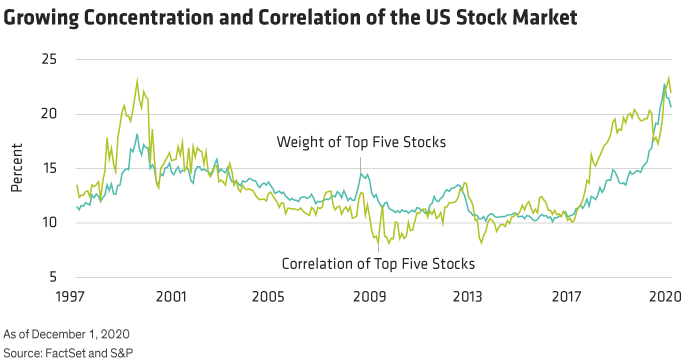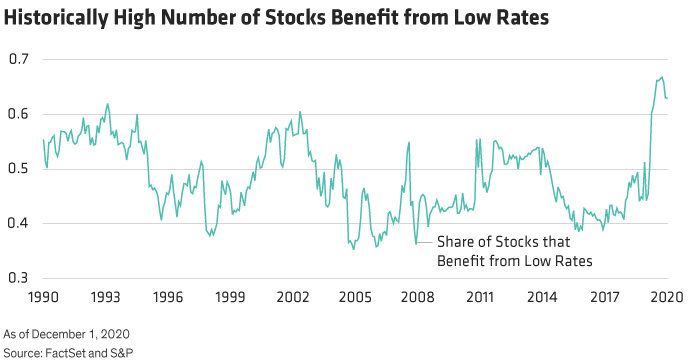Passive investing has grown by leaps and bounds since 2010. Investors have flocked to these strategies—ETFs and index mutual funds—in the hopes of securing a robust portfolio that will deliver market returns at a cheaper price than an active manager could deliver, without the underperformance risk. And so far, they haven’t been wrong. Active management has generally disappointed in the last decade. But the driver behind passive strategies’ better returns is a threat most investors are unaware of—concentration risk. While the investment landscape has been conducive to delivering outsized returns for a select few stocks, what could happen if the favorable environment these companies enjoy sours?
Why Concentration Hurts
Concentration risk increases when exposure to a single stock, sector, or style becomes too large relative to the other parts of a portfolio or index. Sometimes it happens on purpose—when managers take a big, high-conviction “bet” on something. But other times, it occurs when oversight fails, or the investment process lacks the proper mechanism to rebalance. In those instances, the favored positions swell relative to other portfolio holdings, becoming an increasingly dominant part of the whole. This is the case for many portfolios today, especially passively managed ones.
The US stock market has delivered strong returns over the last several years. But as concentration has risen (Display), that robust performance has mostly been fueled by narrow leadership among a handful of companies. Over the last several years, the largest five US stocks have become an increasingly sizable proportion of the overall market—doubling from 11% in 2017 to 22% in 2020. Further compounding matters, not only are these companies taking a bigger share of the market, their performance has also become highly correlated. In other words, these five stocks tend to move up together, and more worryingly, go down together.

As a result of the growing market concentration, passive funds have a disproportionate exposure to these stocks—which makes for a top-heavy portfolio. Investing disproportionately in stocks that continue to deliver outsized returns isn’t necessarily bad. But the performance of a non-diversified portfolio may surprise investors if the tide turns. And no one can predict when the market will shift.
How precarious is the situation? To answer, we must examine the common factors underpinning the collective success (and correlation) of today’s leaders—namely, falling rates and the benefits of platform business models with network effects and “winner takes all” competitive dynamics. These distinctive business models have fostered a virtuous cycle of growing scale and an appreciating currency for M&A. As we discuss below, some signals may point to an inflection point on the horizon. And for highly concentrated passive portfolios, these may be signs of rough times to come.
Rising Rates Shut Off the Growth Spigot
The Fed has kept interest rates near zero through the pandemic to backstop the economy and foster its recovery. But as activity rebounds, longer-term rates are expected to rise. Rates have already begun to ascend; the yield on the 10-Year US Treasury has risen 83 basis points since the beginning of this year.1 Recently successful stocks may be most vulnerable to this move.
Low rates are generally good for all stocks but especially for high-growth stocks. That’s because a stock’s value is determined by the present value of its future cash flows. And since companies with rapid earnings growth depend on the cash flow they generate further into the future, a decline in the discount rate benefits growth stocks disproportionately. However, the converse also holds true. In other words, as interest rates rise, the present value of those cash flows diminishes.
Crowded tech giants aren’t the only names vulnerable to rising rates. Unwitting exposure to interest-rate sensitivity may lurk elsewhere in a portfolio. A review of the S&P 500 reveals that the index consists of a historically high proportion of companies whose stocks rise as rates fall and fall as rates rise. (Display). Any rate increases could cause low-rate-dependent stocks to fall unexpectedly. Portfolios with a high concentration in these names, like passive index strategies, could be in for a rude awakening.

Regulatory Bull’s-Eye
Rising rates aren’t the only wrinkle. Mega-cap tech companies rode the wave of the enterprise effect that propelled their stocks higher, but now they risk becoming victims of their own success. Their size makes them a target for increased regulatory scrutiny as lawmakers fear monopolistic powers will stifle competition and hand control to a select few. Last October, for example, the US Congress released a report on big tech monopolies that called for strengthened antitrust laws and the adoption of new regulations to reduce dominant companies’ power. The report focused on the same companies that have propelled the market higher. But would regulation be value destroying? It depends.
Just as exposure to rising rates differs among companies, regulation will not hit every big tech firm to the same degree. For example, companies that depend on acquisitions to grow could be significantly distressed by regulatory stringency. Organic growth will likely be insufficient to maintain these behemoths’ historical growth trajectory. A loss of M&A would not only reduce their growth potential but would also limit their ability to deploy capital and boost returns. Active managers can weigh this risk and position their portfolios to reduce exposure, but passive strategies will just be along for the ride.
Actively Adapting to the Environment
A shift in rates or regulation doesn’t flash a clear signal of an impending market turn. And even if it did, the intensity or sensitivity to such a change differs by company. Passive funds don’t make any call on positioning in that regard. But active managers can be more selective. So, while these risks exist for every portfolio, active managers can exploit the subtleties among companies by overweighting, underweighting, or simply not owning index constituents. Therein lies the difference between the recent past performance of the market and a future one in which rising rates and greater regulation could sweep these large boats out to stormy seas.
- Shri Singhvi
- Co-Chief Investment Officer—Strategic Equities

